
| - |
Main plants:
- Sweden: Gothenburg (S60, XC60, V70/XC70, S90, XC90).
- Belgium: Gent (V40, S60, XC60)
- China: Chengdu (S60L, XC60), Daqing (S90)
- USA: Charleston, South Carolina (S60, XC90)

2020: 661,713 units
2019: 705,452 units
2018: 642,253 units
2017: 571,577 units
2016: 534,332 units
2015: 503,127 units
2014: 465,866 units
2013: 427,840 units
2012: 421,951 units
2011: 449,255 units
2010: 373,525 units
2009: 334,808 units
2008: 374,297 units
2007: 458,323 units
2006: 428,780 units
2005: 443,963 units
2004: 455,950 units
2021 sales by model:
XC40: 201,037 units
S60/V60: 105,279 units
XC60: 215,635 units
S90/V90: 67,282 units
XC90: 108,231 units
Reference:
https://www.media.volvocars.com/global/en-gb/corporate/sales-volumes
http://www.volvocars.com/intl/about/our-company/investor-relations
The current lineup of Volvo is built on the platforms of Ford. Since the company is now owned by Geely, its technical ties with Ford will be cut and Volvo needs to develop everything by itself. This could be a big challenge.
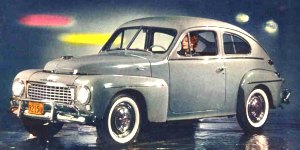 PV444 (1947)
PV444 (1947)However, Volvo cars were no-nonsense and unusually robust. In addition, the low labour cost in Sweden then (a contrast to today) and favourable currency exchange made export to the US market desirable. This was realized in 1947 by PV444, Volvo's first small car. In 12 years, Volvo sold 200,000 units of this car, then followed by another 240,000 units of PV544. The ball started rolling !
An even greater international success was achieved by Amazon (called "120" outside Sweden). It set a new sales record of 667,000 cars in 9 years. Volvo expanded rapidly from the late 1950s to the 60s. A larger plant at Torslanda was opened to take on the growing demand.
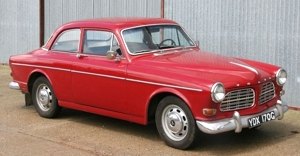 Amazon (1956)
Amazon (1956)The P1800 sports car launched in 1960 surprised many with its beauty - although it was actually designed in Italy and assembled in England. It was still the only 2-seat Volvo until today.
However, more significant to its core business was the launch of Volvo 144 in 1966. Its spacious shape and large windows gave Volvo a no-nonsense image that would carry on for many years. It also established a reputation for safety by introducing 3-point seat belts, crumple zones, all-round disc brakes and fail-safe dual-channel braking system. The 144 series evolved to 240 series in 1974 and served the company until the early 1990s. They were by far the most successful Volvo of all time, recording more than 4 million units of sales. Its motorsport version, 240 turbo, even won European Touring Car Championship in 1985, something you won't believe from its looks !
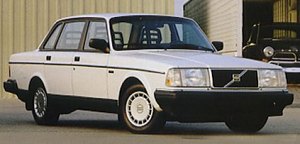 Volvo 240 (1974)
Volvo 240 (1974)Volvo reentered small car segment in the 1970s when it acquired Dutch car maker DAF. This produced the 340/360 series and then 440/460/480 series, both achieved limited success. (The Dutch factory would eventually be sold to Mitsubishi many years later) In comparison, its expansion to the luxury segment in 1982 with 760/740 series was far more successful. In total some 1.2 million copies were produced. This flagship model had an angular shape which would dominate the company's design philosophy for the next 2 decades. It also introduced a V6 engine dubbed "PRV", which was jointly developed by PSA, Renault and Volvo.
The relationship with Renault extended beyond engine sharing - they also talked about a merger. For a few years it seemed very likely to happen, as both companies went as far as stakes exchange. However, the talk eventually broke down in 1993 as both the Swedes and French wanted to take control. While the car division of Volvo was small in comparison with Renault, the whole Volvo group, including trucks and construction equipment business, were at least on equal ground of Renault.
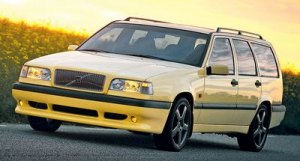 Volvo 850 (1991)
Volvo 850 (1991)Fortunately, product development was not affected by the failure of merger. Volvo introduced a new mid-size car, 850, in 1991. It introduced a new turbocharged 5-cylinder engine (co-developed with Porsche) and sporty handling, successfully changing the company's conservative image. In particular, the hottest T5R model delivered fire-breathing performance never seen in Volvo.
The S80 of 1998 was the last significant Volvo developed completely by itself - and it left us a fond memory of Volvo as an independent car maker. As global competition got intense year by year, Volvo group decided to separate its car division from the group and sold to Ford in 1998. As a result, Volvo Trucks and Volvo Cars became two separate companies.
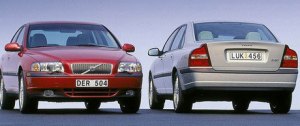 Volvo S80 (1998)
Volvo S80 (1998)Under the umbrella of Ford, Volvo was grouped into PAG (Premium Automotive Group) together with Jaguar, Land Rover, Aston Martin and Lincoln. Its large car platform was shared with its sister companies, while it got small car platform from Ford to produce the new S40 / V50. Despite of the cost advantages of this arrangement, Volvo found it increasingly hard to compete against the dominating German premium brands and the rising Japanese. As Ford itself got into finanical trouble, Volvo was sold to Chinese car maker Geely in 2010.